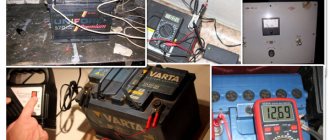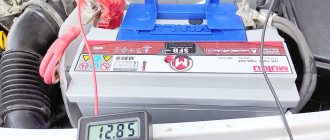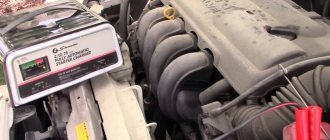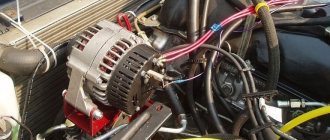How much should the generator produce to charge the battery?
In a car, the car's alternator is responsible for charging the battery. In fact, it is a device that is driven by a motor and converts mechanical energy into electrical energy. In turn, the car battery, spending part of its charge to start the engine and maintain power in the on-board network when the engine is turned off, needs active recharging.
If the system is working properly, the battery is recharged from the generator, and there is no undercharging or overcharging of the battery. However, during the operation of the car, problems may arise for a number of reasons. The result is that the battery fails. In this case, the “health” of the battery deteriorates in all cases (if the battery is very discharged, there is a constant discharge, if it is overcharged, the battery boils).
One way or another, in such a situation a diagnosis is necessary. Next, we will look at how much a car’s generator produces normally, why the generator does not charge the battery, for what reasons overcharging occurs, what voltage should be on the battery, etc.
Is there charging
Once upon a time, car designers came up with the idea of monitoring the presence of charging voltage using a light bulb. It is quite convenient and clear. The lamp is on - there is no charging; it goes off - the car's generator is working properly. The average car enthusiast does not need to delve into numbers and look at the arrows of control instruments. Therefore, this method of control has been preserved on the most modern cars.
But he is not always objective. Sometimes the warning light goes out, and the voltage in the on-board network is not enough to properly charge the battery. This is due to the design features of the relay-regulator. The warning lamp will go out in any case when the generator voltage is greater than the battery voltage. Roughly speaking, even with a voltage of 12.5 V, the indicators on the instrument panel will report the normal operation of the equipment.
Meanwhile, the battery will gradually discharge. This will happen especially intensively in the following cases:
- When standing in traffic jams for a long time with the engine running;
- For short trips with a large number of switched on consumers;
- If the battery life is close to its limit.
If the battery discharge occurs systematically, there is reason to think about checking the charging from the generator.
The generator does not charge: reasons
Let us note once again that a normally operating generator completely replenishes the battery charge level, while the charge decreases under load. At the same time, in the general circuit there are many elements that can cause a battery charge failure. Often, problems arise both in the mechanical part (generator drive, bearings, etc.) and in the electrical part (break or short circuit of windings, burnout of the diode bridge, wear of brushes, breakdowns). The generator relay regulator should also be checked separately.
One way or another, it is important to find the problematic element. Note that usually the vast majority of generator breakdowns or battery charging problems can be eliminated (by replacing the drive belt, rollers, repairing the generator, inspecting contacts, terminals and other elements). However, there are breakdowns that become the basis for replacing the entire generator assembly.
We also recommend reading the article on how to increase the density of the electrolyte in the battery. From this article you will learn what the density of the electrolyte affects, how to measure the density of the battery, and also how to change the density of the electrolyte in the battery.
The terminals must fit tightly; oxidation is not allowed. The same goes for electrical wiring. All wires must be intact, and the contacts must be securely fastened and clean. By the way, it is important to periodically clean the contacts from oxidation, since the current will pass through the oxidized outputs worse.
You should not yet rule out mistakes that may be made during generator maintenance. Incorrect contact connections can cause generator malfunctions, battery discharge and other malfunctions.
Charging control with a multimeter
For those who don’t know, this is a special miniature device, which is most often produced by our eastern neighbors. Its price on the market rarely exceeds 1000 rubles. The prefix “multi” means that it can measure a lot of useful things, but we are only interested in one parameter - voltage. It is its value that will allow us to draw conclusions about the performance of the generator. But before you check whether the battery is charging or not, it’s a good idea to make sure it’s working. Moreover, this can be done using the same multimeter.
Having measured the battery voltage in idle mode, i.e. without load, indirect conclusions can be drawn about the degree of its charge. To do this you need:
- Set the multimeter switch to the position corresponding to the measurement of direct current, with a limit greater than 12 V. The limit in the photo is set to 20 V, but it can be different for different types of measuring instruments. It should only be noted that the lower the limit, the greater the measurement accuracy;
- Connect the multimeter probes to the battery terminals. In this case, it is not necessary to observe polarity; the design of the device allows this. If the connection is incorrect, the voltage value will be displayed with a “-“ sign;
- Read the readings of the device and, using the data in the table, draw conclusions about the state of charge of the battery.
Once again, these are approximate values. More accurate data can be obtained only by measuring the density of the electrolyte. And, nevertheless, if the voltage test showed that the battery is charged less than 50%. it follows .
Now you can check the charging from the car generator. The sequence of actions is the same as in the previous case. The main difference is that the test is performed at idle engine speed. Therefore, safety precautions should be observed. The voltage on the battery, during normal operation of the generator and relay regulator, should be within 13.7 - 14.3 V.
Now you need to turn on the low beam headlights and heated rear window. The voltage on the battery may drop slightly, but not lower than 13.5V. Otherwise, you need to look for the reason. You need to start with the alternator belt, or rather with its tension.
And one last thing. No matter how great the temptation is to switch the multimeter to the current measurement position, you should never do this. In parallel with the battery, only its voltage can be measured. Any attempts to measure the charge current will lead to a short circuit and, at a minimum, failure of the measuring device.
A properly functioning battery will ensure easy engine starting even in the coldest weather. The stable operation of the battery and the entire automotive electrical system certainly depends on the quality of the battery. The battery is supplied with voltage during engine operation by the generator. For this reason, it will be useful to know how to check the charging of the generator.
What's the result?
Taking into account the above information, it becomes clear that if problems begin with the battery, often the cause of the problem is the generator, and not the battery. In this case, the generator needs to be checked comprehensively (alternator brushes, slip rings, windings, generator relays, wiring, terminals, etc.)
Please note that too high a load on the generator (for example, when installing powerful emergency power consumers) in many cases causes rapid failure of the generator. To avoid problems (especially when choosing a new generator), you need to separately take into account some features.
We also recommend reading the article on how to properly charge a battery with a charger. From this article you will learn about the features of charging a battery with a charger, as well as what subtleties and nuances you should pay attention to when charging a car battery.
As a result, we add that every 15-20 thousand km. mileage, it is necessary to check the tension of the generator belt, since loosening it reduces the performance of the generating device. It is also necessary to periodically check the diode bridge, voltage regulator, as well as a number of other elements. At the same time, the terminals are cleaned and the battery is serviced. This approach will allow you to maintain full functionality of the system and eliminate possible unexpected breakdowns.
Generator and battery
So, the gene is almost the main device in the machine. If it does not work, then the car will be impossible to move.
Generator breakdowns can be different, and the reason does not always lie in the unit itself. So, the gene may simply not receive energy from the internal combustion engine.
As for the battery, modern TOP class cars have a special control unit installed that controls the main parameters of the charging process. But on budget car models, such blocks are absent for obvious reasons. Owners of these cars (including domestic ones) have to monitor and control charging themselves.
Charge current and battery capacity
The charge current is the primary consideration during battery charging. In other words, all the main parameters depend on its value.
As a rule, it is customary to talk about a 10 percent charging current for the battery capacity. This is the minimum value that can ensure a normal battery charge. For example, if the battery capacity is 50 A, then the charge should be 5 A. With this charge value, a completely discharged battery will gain its capacity to standard parameters in 10 hours.
Now let's imagine this situation. The car stalled due to a discharged battery on the road, and this happened in winter. Using the lighting method, the car was started from another car. And so, in order for the battery to be fully charged, you will have to drive non-stop for 10 hours. This is approximately 500 kilometers.
Although, to minimally replenish the battery charge, it will be enough to drive 30 km in normal mode, and in urban traffic conditions - even half as much. It turns out that if you drive long distances all the time (more than 15-30 km), then you don’t need to worry about recharging the battery.
But what about those car owners who drive less? The battery capacity is completely consumed during the process of starting the car in winter; the driver reaches his destination and turns off the car. Let's say there is still a little charge left, the car starts, and the driver drives home. The next day the car cannot be moved. The reason is that the battery is dead.
Attention. It is extremely important, especially for those motorists who drive short distances, to warm up the car engine. This is done so that the battery has time to receive a charge from the generator.
Problems with the gene
Generator again? Yes. And it’s scary to even imagine that it doesn’t recharge the battery. In this case, even a 1000 kilometer run of the car will not provide anything for charging.
The gene, in fact, has a simple structure. It is a regular electric motor, but manufactured taking into account higher voltage generation. A better way to imagine how a gene works is to connect an LED to a regular electric motor. As soon as the motor is started, the LED will light up. This is the elementary work of a current generator.
The gene consists of 4 main parts, not counting the body. These are the stator, rotor, brushes and relays. In modern units, relays and brushes are created together and combined into a control unit. The stator is the stationary part of the gene, the rotor is the movable part.
The generator may fail, and therefore not charge the battery, for several reasons. Let's look at the most famous ones.
- Bearing problem. A fairly common problem, especially when the gene is quite worn out. As you know, the rotor or the moving part of the gene rotates on bearings. The latter wear out over time, become clogged with dirt and jam. The consequences are as follows: the rod stops rotating. But it is extremely difficult to determine such a problem from the outside, and the owner operates the gene with flying bearings for some time until the drive belt breaks.
- Stator winding. It simply burns, which also occurs due to the penetration of dirt or moisture into the gene. This causes a short circuit, and boom... the winding burns out. Accordingly, battery charging stops.
- Brush unit. Problems with it occur quite often due to the fact that the brushes are graphite and constantly move along the stator tracks. Over time, they naturally wear out.
- Tablet, relay. It fails, the gene is no longer able to charge. More precisely, the relay regulator is no longer able to control the strength and voltage of the current, and chaos occurs throughout the entire electrical system of the car.
These are the main 4 common reasons for gene failure. The unit should be checked periodically to avoid various problems, including providing constant current to the battery.
How is a car battery charged from a generator?
When starting the car, the battery emits electric current and is discharged. When the car engine is running, the generator produces energy. The on-board electrical station of the car, when the rotor and stator windings interact, produces an alternating three-phase current. The resulting energy replenishes the battery and powers the vehicle's electrical system.
Checking generator operation
You can check the functionality of the generator in several ways using certain methods, for example: you can check the output current of the generator, the voltage drop on the wire that connects the current output of the generator to the battery, or check the regulated voltage.
To check, you will need a multimeter, a car battery and a lamp with soldered wires, wires for connecting between the generator and the battery, and you can also take a drill with a suitable head, since you may have to twist the rotor by the nut on the pulley.
Basic check with a light bulb and multimeter
Connection diagram: output terminal (B+) and rotor (D+). The lamp must be connected between the main output of the generator B+ and contact D+. After this, we take the power wires and connect the “minus” to the negative terminal of the battery and to the generator ground, the “plus”, respectively, to the plus of the generator and to the B+ output of the generator. We fix it on a vice and connect it.
We turn on the tester in DC mode, attach one probe to the battery to “plus”, and the second one too, but to “minus”. Next, if everything is in working order, then the light should light up, the voltage in this case will be 12.4V. Then we take a drill and start turning the generator, accordingly, the light bulb will stop burning at this moment, and the voltage will already be 14.9V. Then we add a load, take an H4 hologen lamp and hang it on the battery terminal, it should light up. Then we connect the drill in the same order and the voltage on the voltmeter will show 13.9V. In passive mode, the battery under the light bulb gives 12.2V, and when we turn it with a drill, it gives 13.9V.
Generator test circuit
Strictly not recommended:
- Check the functionality of the generator by short circuit, that is, “to spark”.
- It is also undesirable to allow the generator to operate without consumers turned on; it is also undesirable to operate with the battery disconnected.
- Connect terminal “30” (in some cases B+) to ground or terminal “67” (in some cases D+).
- Carry out welding work on the car body with the generator and battery wires connected.
How does a car's energy system work?
The three-phase generator produces alternating current, and the power supply is designed for direct current. Therefore, through the rectifier, energy is supplied to the battery, and from there it is distributed to consumers. If the battery does not receive energy from the generator, it will run out and the car will lose power. The battery cannot be fully charged from the car's internal network. External recharging is required periodically.
How to check if the battery is charging from the generator
Before testing the functionality of the generator, you need to make sure that the battery is in good condition. If your car battery is not charging, checking your alternator may reveal mechanical and electrical problems. In VAZ cars, engine starting problems often occur when the generator does not charge the battery sufficiently.
Types of control over the operation of the device:
- Visual inspection. If the battery does not charge, you need to carefully inspect the wiring. Be sure to clean the oxidized contacts from the generator and tighten the connecting fasteners. It is necessary to inspect the battery case - when overcharging due to the fault of the gene, the rate of battery destruction increases. Symptoms: The battery will develop a permanent coating and the charging indicator will glow red.
- After repairing the car, it would be useful to check that the generator is connected correctly by rotation. We connect an anti-fog lamp to the outputs. We apply rotation to the rotor using a drill. If the light does not light up, you need to change the polarity of the connection.
- A working generator supplies a stable voltage of 14.1 - 14.5 V. You can measure the indicator on a bench. Diagnostics is carried out using a battery and a 50 W incandescent lamp. If the glow is bright, the generator is working. This means that the reasons why the car battery is not charging need to be looked deeper.
- Greater accuracy in finding problem areas will be obtained by testing the stator and rotor separately. They are looking for an interturn short circuit or a short circuit of individual wires to the body or a poor connection of the terminals with the contacts. A short circuit is often the reason when the battery of a VAZ car is not charged from the generator.
- Checking the diode bridge for the suitability of all diodes, 3 positive and 3 negative. If at least one of the diodes is broken, the battery will show a low charge.
- The Control Ind alarm can be a signal to check the power supply system. If the car's generator and battery are working properly, the reason why there is no charge may lie in a faulty voltage relay.
Will the battery be charged from the generator if there is damage that prevents the rotor from rotating? Mechanical problems include faults in which the rotor does not spin - a torn or loose timing belt, a crumbling bearing, and the like.
Let's sum it up
When operating a car, it is important that the generator and battery match in power and capacity. It is necessary to systematically clean and check the contacts of the power unit, make instrumental measurements of the idle voltage and operating current at the battery terminals. Turn on the optimal number of service devices so as not to drain the battery when the generator is running.
We invite you to watch the video on checking the functionality of the generator.
The most basic function of the generator is to charge the battery and power the electrical equipment of the engine.
A generator is a mechanism that converts mechanical energy into electrical energy. The generator has a shaft on which a pulley is mounted, through which it receives rotation from the engine crankshaft.
Interactive image of the generator circuit. Works on mouseover
A car generator is used to power electrical consumers, such as the ignition system, on-board computer, car lighting, diagnostic system, and it is also possible to charge a car battery. The power of a passenger car generator is approximately 1 kW. Car generators are quite reliable in operation because they ensure uninterrupted operation of many devices in the car, and therefore the requirements for them are appropriate.
How long does it take to charge a battery from a generator?
The generator and battery must comply with the technical parameters. A full battery charge is enough for several attempts to start the engine with a break between turns of the starter. In this case, the battery does not receive recharge and may be completely discharged.
How long does it take for the car's alternator to charge the battery? Considering that energy replenishment should not be more than 10% of the battery capacity - quite a long time. The supplied energy is immediately used to recharge operating devices. And only the energy reserve replenishes the battery capacity. How long will it take for a battery that is dead when starting the engine to be charged from the generator?
If the power of the generator matches the capacity of the installed battery, the on-board power plant generates 10% of the energy from the battery capacity. How long does the drive need to charge? If its capacity is 60 A/h, then the generator must produce a current of 6 A, excluding consumers. Therefore, the generator power must be greater to compensate for losses, and service devices are selected comparable to the capabilities of the power unit.
If the battery is not charged from the generator, the reason may be a large number of consumption sources that can take up to 80 A. If the generator’s power is insufficient, or it is faulty, will the battery be charged from it? It is necessary to turn off some of the service equipment - media center, air conditioner and the like.
Causes of battery charging failure
The main parameter in the battery charging process is the charge current. Many parameters depend on its value.
Capacity replenishment speed
There is an opinion that for normal battery charging, the charge current should be 10% of its capacity, i.e. with a battery capacity of 50 Amp*hours, the charging current will be 5 Amps. Under such conditions, a completely discharged battery will gain its capacity to its nominal value of 10 hours.
Imagine, you were turned on by the wires of another car in the winter, and in order to fully charge the car battery, you need to drive the car for 10 hours straight, that is, drive about five hundred kilometers.
It is believed that to replenish the battery charge to the nominal value, it is enough to drive 30 kilometers in a normal cycle, and in city traffic jams half that. That is, if your work is located more than 10 kilometers from home, this is enough not to worry about recharging the battery outside the car.
The case is different when work is close to home. You spent the capacity when starting the car, quickly drove to work, and then also home. After a week or two, your battery runs out. And not at all because there is something wrong with the car, it’s just the rhythm of the drive.
In this case, you should think about warming up the engine even in the warm season just to ensure that the battery is always charged.
Let's return to the charge current. If it is enough to drive a car 30 kilometers to fully charge the battery, and not 500, as in the example, therefore, the charging current of the car generator is not 5 Amperes, but much higher.
Battery life
The normal battery life is more than five years. Used cars imported from abroad have fully working seven- to nine-year-old batteries on board. There, however, the storage conditions for cars are different, and the temperature in winter is higher.
There are three reasons for the low durability of the battery: violation of the battery charging mode, the quality of the battery, the human factor, in other words, laziness.
Let's start with the first one. If the battery is not charged to full capacity all the time, the plates undergo a sulfation process. Sulfation, or the formation of lead sulfate on the plates, can be compared to a stomach ulcer in humans, only in humans it can be treated, but a battery ulcer is practically untreatable.
There are various methods of complete discharge-charge, charging with pulsed currents. Maybe there is some percentage recovery, but if the battery is completely dead, then alas...
The quality of the battery depends on the manufacturer. Modern technologies only affect the increase in battery capacity while reducing the size and weight, respectively, the amount of lead.
How to choose the best quality battery? If there are two different copies with the same capacity, starting current, cost, it is better to buy the one that is heavier, it has more lead, it will last longer.
About the human factor. The biggest mistake car owners make is parking the car in the fall with the battery until spring.
If the battery spends several months in a discharged, not even fully charged state, and even in the cold with a reduced electrolyte density, it is unlikely to survive until spring.
If you periodically use your car in winter, then regularly (a couple of times a week) you need to start the car and warm it up for at least fifteen minutes, checking the charging voltage.
If the car is not used in winter, it is better to remove the battery from the car, fully charge it and store it in a warm room, recharging it once a month.
During daily operation of the vehicle, it is necessary to regularly check the charging of the battery from the generator.
How long does it take to charge a car battery from a generator?
How long it takes to charge a car battery from a generator is an imperial indicator. It depends on the ease of starting - how many times the starter was turned. The remaining charge of the battery after a long period of parking varies, as do the temperature conditions. Therefore, restoration of battery capacity depends on the technical parameters of the generator, at what speed it produces current, and how many additional devices are powered.
However, it is known that in order to restore the battery’s ability to start the engine, you need to idle and drive at average speed for at least 20 minutes. To fully restore capacity, it will take at least 3 hours of continuous vehicle movement.
How long a battery is charged from a car generator depends on the ambient temperature and the condition of the battery. But as the electrolyte heats up, the chemical process proceeds faster and less external energy is required. How quickly the charge accumulation process occurs depends most on how long the generator operates. Therefore, on long-distance vehicles, batteries are rarely charged from the network.
Signs of a generator malfunction
In modern cars, breakdowns of the electrical system are one of the most common. A large number of electronics requires particularly careful monitoring of the operation and condition of the generator and battery, because their failure can immobilize the car. The most common signs of a generator malfunction are:
- battery indicator light on the instrument panel;
- unstable operation of the battery (its boiling over or undercharging);
- different intensity of headlights;
- extraneous sounds from the generator.
If you notice incorrect operation of the car, then perhaps the battery charging current from the generator is insufficient.
All malfunctions of electrical equipment, which includes the vehicle’s energy-generating device, are mechanical (deformation or breakage of fasteners, housing, malfunction of bearings, pressure springs, drive belt, etc.) or electrical (winding breaks, diode bridge malfunctions, burnout or wear of brushes , short circuits between turns, breakdowns, etc.).
Don’t write off a non-working generator: find out if there are repair kits and spare parts. Replace them if possible. If you cannot carry out repair work yourself, then take the generator to a workshop. Many craftsmen will be able to restore the unit at no extra cost and in the shortest possible time.
However, some breakdowns require the purchase of a new device that generates electricity. For example, a failing bearing that is soldered into the generator housing cannot be restored or replaced in most cases.
Remember that failure of this unit can be caused not only by wear and corrosion, but also by poor quality of elements and components; excessive load; external influence of salts, liquids, temperatures.
What voltage should you charge your car battery with?
Charging Varta battery
A discharged battery does not always require purchasing a new one; often it is enough to charge the old one; the procedure is inevitable with frequent cold starts and short trips. The most affordable chargers are manually controlled; the owner must know what voltage to charge the car battery with.
Requires direct current, voltage up to 16.5 Volts. Charging occurs in one of two modes: at constant current or constant voltage.
Car battery charging current and time
The charging current is selected so that it is no more than ten percent of the battery capacity. That is, a battery with a capacity of 55 Amp-hours needs to be charged with a current of 5.5 Amp for 10 hours.
However, in practice everything is much more complicated, therefore, to avoid excessive gas formation, you should check the condition of the battery every hour or two. At the end of the charging cycle, it is recommended to gradually reduce the current, constantly monitoring the voltage at the battery terminals. Modern chargers take responsibility for regulating the charging current, so human intervention is generally not required.
To summarize, it should be noted that if the battery operates under normal conditions without deep discharges and recharging, and is serviced every year, then it will be able to cope with its direct responsibilities for five to seven years without any difficulties. It is only important to regularly check the condition of the battery and charge it correctly if necessary.
Charging with constant current
Charging the Bosch battery
The charger is set to a current equal to 10% of the rated capacity. For example, a 12 Volt battery with a capacity of 55Ah requires a current of 5.5A, for a 60Ah battery - 6A. In this case, the current strength must be regularly monitored and adjusted, as it tends to go astray.
If the current is maintained at 10% at the end of the charging process, strong gas evolution occurs. Therefore, when reaching 14.4 Volts, the current strength is reduced by 2 times. For maintenance-free batteries, it is halved again when the voltage shows 15 Volts.
Find out the charging time of your battery
A 12 Volt car battery is charged when its voltage and current do not change for 2 hours. For full operation, it is enough to save the parameters for 1 hour. This usually occurs at 16.3(±0.1) Volts.
Voltage-saving charging
A 12 Volt battery will be charged in a day:
| Charging voltage, Volt | Accumulated capacity per day, % of nominal |
| 14,4 | 80(±5)% |
| 15 | 85-90 |
| 16 | 95-97 |
| 16,4 | 100 |
For a heavily discharged battery, the current at the beginning of charging can reach high values, which can lead to battery failure, so the indicator is limited to 20A.
As charging progresses, the current decreases and eventually approaches zero. This method does not require constant monitoring by the owner. You can control the process a day after the start by measuring the voltage at the terminals. If it is 14.4(±0.1) Volts, charging is complete. Maintenance-free batteries usually take more than a day to reach this point. On devices equipped with an indication, a signal will light up indicating completion.
Charging calcium batteries
Charging the calcium battery
Old dry-charged batteries are charged with a 10% current; a voltage of up to 16 Volts is permissible for them. The new 12 Volt Ca/Ca batteries quickly fail from such a high voltage.
The maximum permissible value for them is 14.4 Volts at a current of 10% of the capacity. Such charging requires more time, but does not shorten the life of the battery.
Charging 6 Volt batteries
6 Volt batteries are often used in:
- motorcycles, scooters;
- boats;
- trade, warehouse, industrial equipment;
- children's cars;
- wheelchairs.
Given the widespread use of 6 Volt batteries, they are available in a wide range of capacities, they can have either 1.2Ah or 16Ah, or any value in between.
Charging such batteries with a car charger is problematic. Close monitoring and constant adjustment of the current will be required. The risk of overheating is high. The most suitable charger for a 6 Volt battery is the Imax B6 charger or similar. Current 10% of capacity, voltage up to 7.3V.
Charging lithium polymer batteries
Lipo 3.8 V are charged with the devices that come with them, or with chargers like the Imax B6.
The batteries are charged with current from 20 to 100% of the rated capacity. For batteries, smaller values are preferable. The main question is, what voltage does a charged battery show? Having reached 70-80%, charging begins at a constant voltage and decreasing current.
Lithium polymer battery
Special devices for Lipo 3.8 V signal the end of charging when reaching 70-80% capacity. A further increase in density ensures less frequent charging, but shortens the life of the battery as a whole.
When charging 3.8 Volt lithium polymer batteries, the charger should show 4.2 Volts. If you can set it to 4.1 Volts, it will take a little longer to charge, but the battery will last much longer.
Charging the battery without removing it from the car
The methods described above involve charging from a wall outlet, which usually requires removing the battery. However, charging can also occur under the hood. Modern portable devices, such as CTEK, have compact dimensions and allow you to charge a 12V battery under the hood. They can be left overnight so that the battery is in working order in the morning. Such chargers are especially relevant for car owners with calcium batteries.
Charging a car battery with a charger
Obviously, it is more advisable to charge a car battery with a charger at home, where a comfortable temperature is provided and there is access to a 220 V household network. To do this, you will have to remove the battery from the car, having first disconnected the terminals. First of all, remove the negative terminal, and only then the positive one. After this, you should wipe the battery case from dirt and dust, and also thoroughly clean the output contacts.
In winter, before charging a car battery, it is better to let it stand for a certain time at room temperature and only then begin the procedure. If the electrolyte, due to the severe discharge of the battery and the low temperature outside, has frozen (yes, this also happens), then you just need to wait until the moment when it acquires a liquid state again. This may take up to several hours. Freezing of the electrolyte is extremely undesirable, as it can significantly reduce the service life of the battery. Also, battery life is greatly reduced due to deep discharges.
If the battery belongs to the serviceable category, then before charging it it is necessary to unscrew the lids of the cans so that during the charging process they do not break off as a result of the high pressure of the released gases. Only after completing this procedure can you safely begin charging the battery.
If the battery is maintenance-free, then you can skip the above-described manipulations and immediately connect the charger, strictly observing the polarity. To avoid incorrect connection, the positive terminal of the battery is made larger in size. In addition, near each output there is a corresponding marking “+” or “–”. Similar markings are available on the charger terminals. We connect plus to plus, and minus to minus, and then press the start button.
With automatic charging, everything is simple - after connecting, the device itself determines the required mode and also stops the cycle without third-party intervention. When working with manual memory devices, you will have to select the required operating mode yourself. True, such chargers can be found less and less in stores, so we will not dwell on the intricacies of their operation.
After the battery is fully charged, it will not be superfluous to check the density of the electrolyte to make sure that the battery is in good condition and its self-discharge is minimal. This operation is performed using a special device - a hydrometer. The electrolyte density of a fully charged battery (terminal voltage is 12.8 V) should be in the range from 1.25 to 1.28 g/cubic meter. see. If deviations are observed, then it is necessary to adjust the proportions of the electrolyte. In addition, you need to make sure that the electrolyte level is within normal limits. If it is less, then distilled water should be added, while controlling the density.











